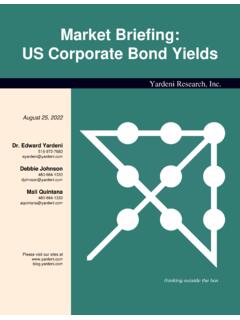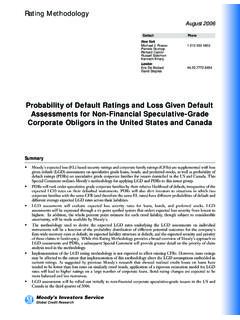Transcription of Corporate Bond Market Trends Emerging Risks and Monetary ...
1 Corporate bond Market Trends , Emerging Risks and Monetary PolicyCorporate bond Market Trends , Emerging Risks and Monetary Policy This work is published under the responsibility of the Secretary-General of the OECD. The opinions expressed and arguments employed herein do not necessarily reflect the official views of OECD member countries. This document, as well as any data and any map included herein, are without prejudice to the status of or sovereignty over any territory, to the delimitation of international frontiers and boundaries and to the name of any territory, city or area. OECD 2020 Please cite this report as: elik, S., G. Demirta and M. Isaksson (2020), Corporate bond Market Trends , Emerging Risks and Monetary Policy , OECD Capital Market Series, Paris, This report is part of the OECD Capital Market Series.
2 More information about the series is available at: Any questions and comments are welcome and should be addressed to: Mr. Mats Isaksson Head of Division Corporate Governance and Corporate Finance Division Directorate for Financial and Enterprise Affairs, OECD [Tel: +33 1 45 24 76 20 | FOREWORD By the end of 2019, the global outstanding stock of non-financial Corporate bonds reached an all-time high of USD trillion in real terms. This record amount is the result of an unprecedented build-up in Corporate bond debt since 2008 and a further USD trillion in borrowing by non-financial companies during 2019, in the wake of a return to more expansionary Monetary policies early in the year. The new data in this report shows that, in comparison with previous credit cycles, today's stock of outstanding Corporate bonds has lower overall rating quality, higher payback requirements, longer maturities and inferior investor protection.]
3 This report presents: recent developments and Emerging Risks in the Corporate bond Market the use of rating-based investment and the holders of Corporate bonds credit rating methodologies and historical Trends in rating changes It builds on a dataset of more than 92 000 unique Corporate bond issues by non-financial companies from 114 countries between 2000 and 2019. A description of data sources as well as the methodology for data collection are provided in the annex. The report builds on earlier work by the OECD Corporate Governance Committee on Corporate finance and the development of more complete capital markets in the form of equity and long-term debt financing. The content and methodologies used in this report are provided as a basis for discussion with OECD committees and other experts about further work on Corporate bonds as a source of Market -based financing.
4 The report is part of the OECD Capital Market Series, which informs policy discussions on how capital markets can serve their important role to channel financial resources from households to productive investments in the real economy. This report has been developed by Mats Isaksson, Head of the Corporate Governance and Corporate Finance Division of the OECD Directorate for Financial and Enterprise Affairs; Serdar elik, Senior Economist in the Corporate Governance and Corporate Finance Division, and G l Demirta , Visiting Researcher from Sabanci University. The authors are grateful to their OECD colleagues for valuable comments, in particular Juan Yermo, OECD Deputy Chief of Staff; Yoshiyuki Fukuda and Lukasz Rawdanowicz (Economics Department); and Adriana De La Cruz, Alejandra Medina, Tugba Mulazimoglu, Robert Patalano and Yun Tang (Directorate for Financial and Enterprise Affairs).
5 Further thanks to Pamela Duffin (OECD) for excellent editorial support. G l Demirta would like to thank the Swedish Corporate Governance Forum of the Karl-Adam Bonnier Foundation for its financial support for her work. Corporate bond Market Trends , Emerging Risks and Monetary Policy 5 EXECUTIVE SUMMARY After a return to more expansionary Monetary policies in early 2019, the world s non-financial corporations borrowed an additional USD trillion in the form of Corporate bonds. In real terms, this is equivalent to the amount borrowed in the previous record year 2016 and represents a clear reversal of the decrease in Corporate bond issuance during 2018. Adding the record borrowing during 2019 to the unprecedented build-up of Corporate bond debt since 2008 means that the global outstanding stock of non-financial Corporate bonds at the end of 2019 reached an all-time high of USD trillion.
6 In addition to its growing size, policy makers need to consider that the quality and dynamics of the outstanding stock of Corporate bonds have changed. Compared with previous credit cycles, today s stock of outstanding Corporate bonds has lower overall credit quality, higher payback requirements, longer maturities and inferior covenant protection. These are features that may amplify the negative effects that an economic downturn would have on the non-financial Corporate sector and the overall economy. As a result, the size, quality and dynamics of today s Corporate bond markets has become a factor to consider in the different scenarios that underpin Monetary policy. Supported by a low-interest-rate environment, the mechanics of the credit rating system have allowed companies to increase their leverage ratios and still maintain a BBB rating, which has come to dominate the investment grade category.
7 Over the last three years, BBB rated bonds have made up 52% of all new investment grade bond issuance. As BBB is also the lowest rating in the investment grade category, the significance of the demarcation line between investment and non-investment grade bonds has become increasingly important. Absent the support of low interest rates or in the case of a business downturn, the same rating mechanics that allowed increased leverage will lead to downgrades that increase the borrowing costs for companies and limit their scope for investments. Extensive migration of bonds from investment grade status to non-investment grade status will also test the liquidity of the non-investment grade bond Market , as many large investors will be obliged to sell in order to meet their capital requirements and rating-based investment mandates.
8 Given that the average original maturity of investment grade Corporate bond issues worldwide has increased from 9 to 12 years, the decrease in the value of bond portfolios that follow from the downgrades will be more pronounced. Some key findings: Extended growth in Corporate bond borrowing. Since 2008, the annual global issuance of Corporate bonds has averaged USD trillion. This is double the annual average between 2000 and 2007. As a reaction to successive increases in interest rates, announcements of a less accommodative Monetary policy and fears over slowing growth, Corporate bond issuance declined significantly during the second half of 2018. However, when major central banks announced in early 2019 that they were ready to reintroduce or adjust their accommodative policies, the issuing of Corporate bonds rebounded pushing the total amount issued in 2019 to the equivalent amount they borrowed in the previous record year 2016 at USD trillion.
9 EXECUTIVE SUMMARY 6 Corporate bond Market Trends , Emerging Risks and Monetary Policy Long-lasting decline in overall bond quality. In every year since 2010, around 20% of the total amount of all bond issues has been non-investment grade and in 2019 the portion reached 25%. This is the longest period since 1980 that the portion of non-investment grade issuance has remained so high, indicating that default rates in a future downturn are likely to be higher than in previous credit cycles. Importantly in 2019, the portion of BBB rated bonds the lowest quality of bonds that enjoy investment grade status accounted for 51% of all investment grade issuance. During the period 2000-2007, the portion was just 39%.
10 Lower quality bonds now dominate. In December 2019, the global outstanding amount of non-financial Corporate bonds reached USD trillion. In real terms, this is more than twice the amount outstanding in December 2008. Large issuance of BBB rated bonds, non-investment grade bonds and bonds from Emerging Market corporations since 2008 has resulted in a situation where lower credit quality bonds have come to dominate the global outstanding stock. In 2019, only 30% of the global outstanding stock of non-financial Corporate bonds were rated A or above and issued by companies from advanced economies. In addition, for Emerging Market issuers and non-investment grade and unrated bonds issued by companies from advanced markets, the total payback or refinancing requirements within the next three years is USD trillion, equivalent to 41% of their total outstanding amount.

















